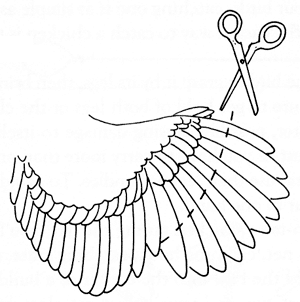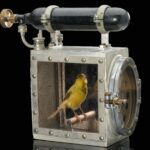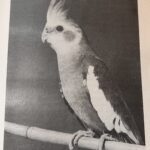
Arguments against wing clipping
There are some topics in the bird community that are very controversial and for which opinions are very divided. Wing clipping is near the top of the list.
It’s not hard to find articles weighing the pros and cons of wing clipping, so I wasn’t wanting to write another one. However, I feel that in these articles, important downsides to wing clipping are not mentioned. To have an honest debate, all the arguments need to be on the table.
Here’s just one example. The article only presents one downside: lack of exercise. The text I quoted makes people feel bad about not clipping wings and typical of articles you’ll find.
If you care about your parrot and want to keep them safe, then clipping their wings is generally a good idea. Whether your parrot stays inside 24 hours a day, 7 days a week or not, the bottom line is that you don’t want your parrot to fly away where they can get into harm’s way.
Should I Clip My Parrot’s Wings? Pros and Cons Revealed
Although I’m opposed to wing clipping in general, I’ve had an unclipped bird escape and never return. So I’m painfully aware of the consequences of allowing pet birds to be fully flighted.
Addressing the emotional argument, I think you can make an obvious comparison to not letting your children drive because they could get into a car accident and die. Everything in life is a tradeoff, the weighing of risks against freedom and rewards.
Now I’d like to present these arguments against wing clipping in the hope that when you make your own personal decision on what to do that you have considered all the consequences.
Downsides to wing clipping
Lack of exercise
Based on three scientific articles listed below and some really boring math, one can come up with a VERY rough estimate that a migrating songbird uses 22 times as much energy to fly as a human does to run the same distance. Flight is an extremely high calorie burning activity.
Costs of migration in free-flying songbirds—Nature—June 2003
Energy cost of running—Journal of Applied Physiology—March 1963
Spring running: A new energetic approach—Journal of Experimental Biology—2005
Note that this calculation takes into account the relative weight of a bird to a human. Although a properly clipped bird can fly limited distances, you won’t often see them do ten laps around a large living room before landing out of breath. That’s real exercise.
Self-inflicted injury
Although a flighted bird can get injured, a skilled flier can keep out of trouble or escape it. A fully flighted bird is less likely to end up in a large pot of boiling water or an open toilet and if they do, they have more ability to escape.
Crash landing can lead to trauma, fracture, broken bones, and broken blood feathers, which can lead to bleeding to death in some cases. Also, broken tail feathers affect balance, both when perching and when flying. Poorly flighted birds often end up crashing into walls and quickly sliding down into trouble.
Stepping on
A poorly flying bird is more likely to end up on the ground, where they can be stepped on by humans. It happens.
Predators
While a clipped bird can fly to a limited degree, their ability to escape predators is greatly diminished. Indoor cats might be one example, but people will sometimes bring clipped birds outside where they are fair game for hawks, dogs, or other predators.
False sense of security
I often assist when local birds escape and when I ask if the bird is clipped, as often as not, the answer is they are clipped. Unless it’s done correctly and repeated as feathers re-grow, a clipped bird could fly enough to escape such that they are difficult to find or retrieve. Also, some birds such as cockatiels as very strong fliers and if sufficiently motivated will surprise you by flying better than you expected them to.
If your bird is clipped you may be less careful about keeping doors and windows closed when they are out of their cages or if clean their cages outdoors with the bird inside.
Bird happiness
There is some evidence that birds have the capacity for fun and that flying is one of those activities.
Birds engage in three types of play. First, locomotor play, which includes all types of flight-related play such as aerial acrobatics, hanging and flying upside down.
Do birds have the capacity for fun?—Current Biology—Jan 2015
It generally seems logical that if a bird is doing laps around your living room and ending up at the same place that they are likely doing this by their own choice and that it’s enjoyable to them.
Clipping juvenile birds
There is some evidence that clipping juvenile birds at a specific stage of development means that you permanently damage their ability to fly to their full potential. There is some thought that a bird must learn how to fly first and then the decision to clip must come later.
It is generally considered very important for a young bird to be allowed to fledge (learn to fly) properly, prior to any wing clipping. Breeders and owners usually find that a fledged bird, even after being clipped, will remain more confident and active than an unfledged bird. Learning to fly also helps a bird learn how to land safely, an important skill even in clipped birds.
Wing clipping—Wikipedia
Proper wing clipping
There are right ways and wrong ways to do wing clipping. And it’s an ongoing process as birds molt and also lose feathers outside of the molt cycle. The molt cycle is not always predictable.
If you don’t clip enough, you risk thinking you’ve grounded your bird but in fact, they can fly fine. If you clip too much, you risk serious injury if a bird hits the ground too hard at the end of a flight. If you don’t clip evenly, you risk a bird flying in an unstable fashion.
If you go to a vet instead of clipping yourself, you are going to be safer. But if you don’t, bad things can happen such as inadvertently clipping one or more blood feathers.
Behavioral issues
With larger parrots in particular, they need a lot of stimulation to avoid boredom. This can lead to things like feather plucking, illness, or depression. Flying is simply just another activity on the list of things a bird can do with its day.
I fly several cockatiels in my house and they take laps every 10 minutes or so, then pant a lot, then rest. That occupies a sizeable chunk of time that they could otherwise be bored.
Conclusion
One option to consider if you are on the fence is “recall training” which is teaching your bird to come to you on queue.
This combines the best of both worlds. You’ll have a fully flighted bird, but if the worst case scenario happens and they escape, you stand a significantly higher chance of recovering your bird.
This is an excellent article that includes information on recall training so they will come to you on cue.
Caveats
Recall training is not foolproof. Just like with clipping birds, don’t let yourself fall into a false sense of security thinking that if your bird gets outside, you will get it back for sure.
When small birds such as cockatiels, lovebirds, and parrotlets escape, they are easier prey for hawks and some other animals. Even if you teach them recall, the world is a more dangerous place for them, even if they are excellent fliers.
Tradeoffs
Pretty much any decision you make for your bird involves some tradeoffs. Allowing them to fly has many physical and psychological benefits. Your bird will likely live a longer and happier life because of it and stand less chance of serious injury. But they could escape. It’s a roll of the dice but it’s important to look at the big picture and not eliminate risk to the point that your bird suffers.





